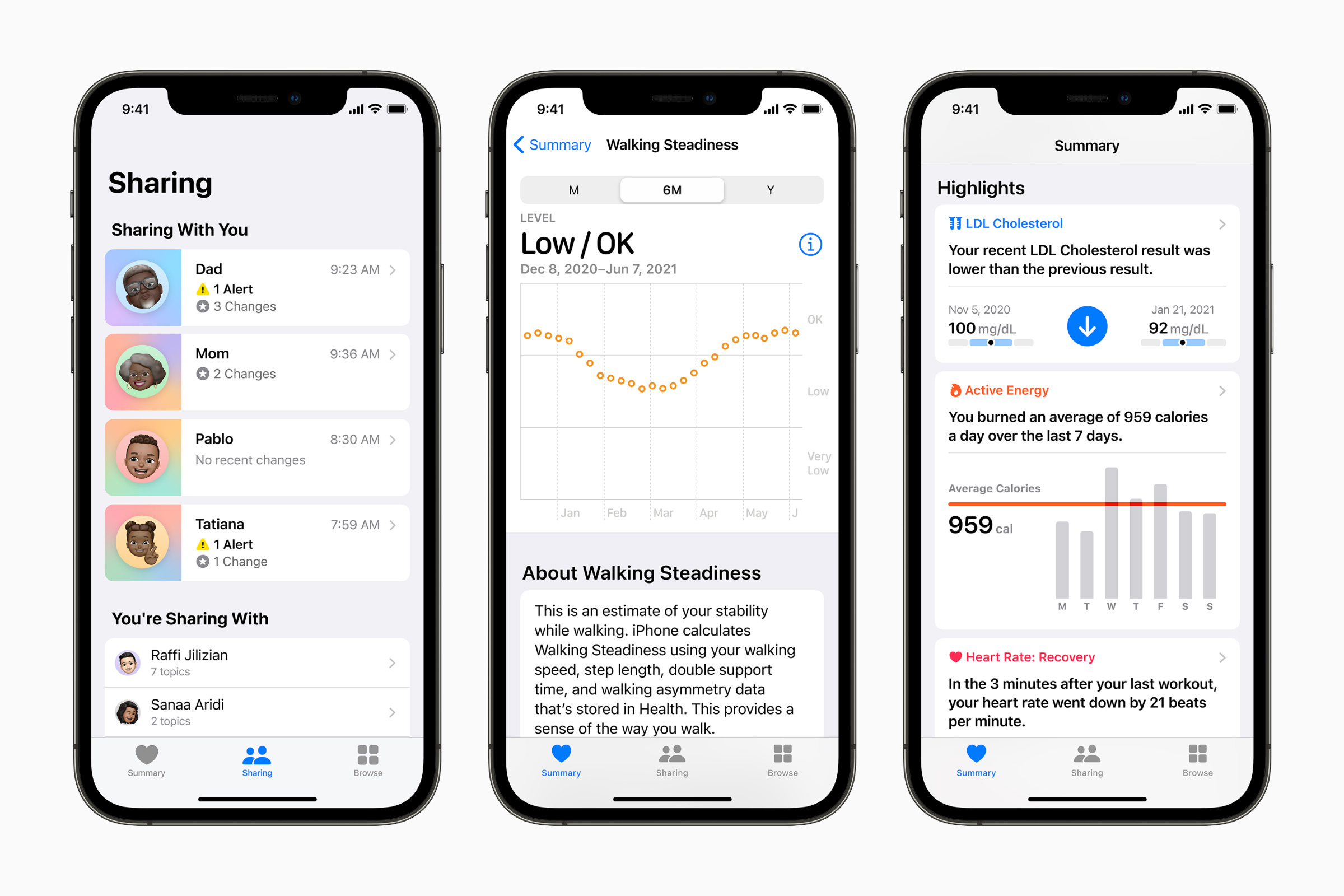
When Apple’s iOS 15 goes live Monday, it will come with the usual bevy of software upgrades meant to enhance slightly older iPhones while also laying the groundwork for the Cupertino, Calif. company’s next generation of devices. While most of the tech world will be focused on the headline changes, like a long-overdue overhaul of the default Weather app that centers more useful information, iOS 15 also introduces some major new health features, including new trend analysis and notification abilities, data sharing features, first-of-their-kind health metrics and more.
“Since 2014, the Health app’s mission has been to help you make sense of your own health data, and making sure it’s private and secure, all in one place,” says Dr. Sumbul Desai, Apple’s VP of Health. “And what you’re going to see on Monday with iOS 15 is that the Health app really comes full circle.”
Via the Health app, iPhones have long been able to store users’ health data, whether it’s collected by the handset itself, an Apple Watch, or a compatible third-party device. But iOS 15 brings two new features to the Health app meant to make that data easier to share with others. The first allows iPhone users to share their health metrics with their loved ones, so that, for instance, an adult son or daughter can keep tabs on their parents’ wellbeing, and get an early heads up if anything seems amiss. The second allows easier sharing of users’ health data directly with their physicians.
Read More: 5 Big Takeaways From Apple’s iPhone 13 Event, Including 1 Thing iPhone Users Should Do Right Now
When it comes to sharing health data, there are obvious privacy concerns at play that will likely be top of mind for many right now, given that Apple recently had to patch a majority security vulnerability in iPhones and other devices. But Desai says Apple has taken steps to ensure users’ personal information is kept secure—the company doesn’t have access to shared data, for instance, and all shared information is end-to-end encrypted. Furthermore, activating the sharing-between-loved-ones feature requires approval from both parties involved, and people can choose which specific kinds of data they want to share while keeping other metrics to themselves. Apple was also careful to design the data in a way that’s helpful, rather than overwhelming, for physicians and other medical workers.
“We wanted to make sure that we could present the information [to health practitioners] in a really easy-to-understand, beautiful way that is easily glanceable and should not take more than a few seconds for an individual to process,” Desai says. “There were times when we were designing the dashboard, if something was too complicated, a lot of us would often say, ‘okay, that’s not going to work, because that’s going to make me think about it two times.’ And that’s taking away precious physician-patient time, [which] we didn’t want to do.”
Also included in the revamped Health app: an entirely new health metric called Walking Steadiness, which uses the iPhone’s built-in sensors to track owners’ balance, strength and gait, and can alert users if they’re at risk of falling. The app also includes exercise tutorials designed to help those who need to boost their steadiness to help prevent falls, which can sometimes lead to serious injury. The feature, Desai says, came about via data from Apple’s heart study, which included more than 100,000 participants.
Read More: Tim Cook on the ‘Basic Human Right’ of Privacy and the Technology That Excites Him the Most
“This feature is an example of research and science really coming together,” Desai says. “When we started our journey in health, we wanted to make sure that we were partnering with the medical community and science and providing actionable recommendations that can really empower an individual with timely information. And so Walking Steadiness, in our view, really has the potential to increase awareness amongst many who may not know that they may have a problem, and potentially proactively indicate that there are some things that you could start working on.”
The Health app is, of course, most powerful in combination with the Apple Watch or other wearable devices, which track metrics—like heart rate, blood oxygenation and more—that the iPhone can’t monitor on its own. But some of the new features in iOS 15, including the new Walking Steadiness metric, don’t require a secondary device, making them accessible to a wider audience at a relatively lower cost of entry. When asked whether Apple would ever consider opening up these Health features for use on non-Apple devices, given their potential to help improve people’s lives and well-being, Desai said that Apple doesn’t comment on future features, but added that it’s “always open to learning about more opportunities for us to consider.”
Overall, Desai says, Apple hopes that the new features can offer a “look at your health in a longitudinal way.” “For health, too often, it’s episodic moments of interaction,” she says. “We really want to start having the conversation and change the conversation around being proactive and preventative about your health, and we’re hopeful these sharing features will start a conversation about proactively noticing changes in trends over time.”
More Must-Reads from TIME
- Cybersecurity Experts Are Sounding the Alarm on DOGE
- Meet the 2025 Women of the Year
- The Harsh Truth About Disability Inclusion
- Why Do More Young Adults Have Cancer?
- Colman Domingo Leads With Radical Love
- How to Get Better at Doing Things Alone
- Michelle Zauner Stares Down the Darkness
Contact us at letters@time.com